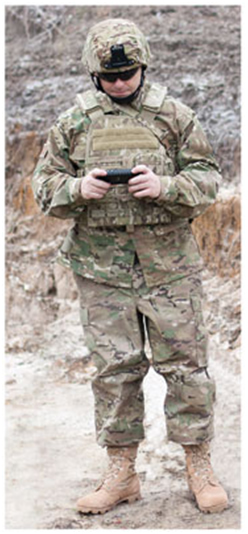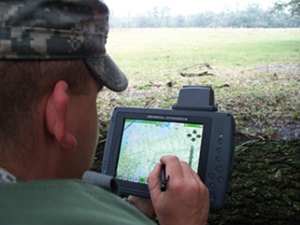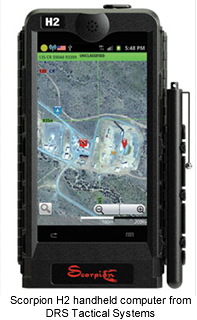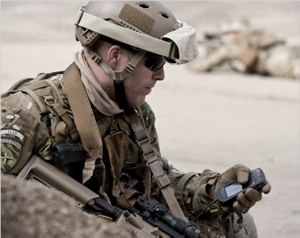The Need for Speed – Rugged Mobile Devices in the Military
The Need for Speed – Rugged Mobile Devices in the Military
One of the earliest adopters of rugged handheld computers was the US military, and today the military remains one of the largest users of these devices. Military personnel all over the world use wireless handheld computers to take inventory of supplies and equipment, record inspection and maintenance data, manage shipments, and support other military operations. Many of these activities take place in remote locations requiring specialized, ruggedized mobile computing devices.
 Rugged computing devices have become much more sophisticated and advanced in the last few years. Design and functionality are two reasons why the rugged computer segment is growing faster than other computer segments. Unsurprisingly, there is a very significant demand for this technology for use in industrial, security, and military applications. And even for basic, commercial needs, it has become trendy to own a rugged computer.
Rugged computing devices have become much more sophisticated and advanced in the last few years. Design and functionality are two reasons why the rugged computer segment is growing faster than other computer segments. Unsurprisingly, there is a very significant demand for this technology for use in industrial, security, and military applications. And even for basic, commercial needs, it has become trendy to own a rugged computer.
Military Adopting Commercial Technologies
The commercial market is setting the pace for the use of mobile devices across multiple markets and applications. As defense personnel see computing devices used in different ways in the civilian world, they are adapting them for similar applications in the military. As prices drop, and the selection of different form factors increases, it is becoming easier to adapt mobile devices for new defense-related functions. Rugged mobile devices are now doing the same things on the battlefield that they have been doing in the civilian world.
In today’s military applications, small size and weight, low power consumption, and big functionality are requisite in rugged mobile computing devices. Not only are size and functionality major concerns, but the ability to consolidate many different functions into extremely small packages is a necessity.
Data must be securely stored within the computer, and handhelds must also satisfy all wireless communication and network security requirements. The application software needs to integrate with central systems, and data must pass seamlessly between mobile devices and headquarters systems.
Rugged computing devices need to be able to withstand extreme environments, so they can be used in any outdoor location during mission-critical events, including the battlefield. There are two main military standards for classifying rugged computers:
- MIL-STD-810 establishes specifications and testing procedures for low pressure for altitude testing; exposure to high and low temperatures plus temperature shock; rain; humidity, fungus, salt fog; sand and dust exposure; leakage; shock and vibration. Handheld and wearable computers must be designed to meet MIL-STD-810G drop specifications. In-vehicle computers must be designed and tested to MIL-STD 810E for vibration, shock, and crash hazard.
- IP scale: IP stands for Ingress Protection and the ratings are displayed as a two-digit number. The first digit reflects the level of protection against dust; the second digit reflects the level of protection against liquids. For example, an IP67-rated unit is totally dust-proof and is capable of immersion in water for at least 30 minutes to a depth of one meter.
The draw of having computing devices for individual soldiers is versatility and situational awareness. There are numerous opportunities for applications to provide valuable service to the warfighter who deals with an  increasing volume of information being sent by UAVs, satellites, sensors, aircraft, ground vehicles, and other soldiers. Fast response times during conflict require quick and accurate communication. This has driven a need for information to be integrated through rugged handheld computing devices in order to accommodate the large amount of situational awareness information provided to troops on the ground. With portable form factors, such as tablets and smartphones, warfighters can access the information they need where and when they need it.
increasing volume of information being sent by UAVs, satellites, sensors, aircraft, ground vehicles, and other soldiers. Fast response times during conflict require quick and accurate communication. This has driven a need for information to be integrated through rugged handheld computing devices in order to accommodate the large amount of situational awareness information provided to troops on the ground. With portable form factors, such as tablets and smartphones, warfighters can access the information they need where and when they need it.
Android has been selected as the operating system (OS) of choice over Apple iOS and Microsoft Windows Mobile, as it offers the greatest potential for developing or adapting mobile computer applications. It was also determined that Android OS will be used for future soldier devices, including rugged, mobile tablets, computers, and cell phones. Using the same handheld computer devices with a uniform operating system helps to ensure continuity and optimization. Another benefit is not being limited to using a particular smartphone model, allowing the military to rapidly acquire the latest technology. The most significant feature that Android is missing is a heavy layer of security.
Security
 Military spokesmen often cite security as the number-one problem with smartphones. Military computing devices that carry, send, and receive mission-critical information call for data security. These devices must meet certain National Security Agency (NSA) standards.
Military spokesmen often cite security as the number-one problem with smartphones. Military computing devices that carry, send, and receive mission-critical information call for data security. These devices must meet certain National Security Agency (NSA) standards.
The Information-Assurance (IA) imperative is one of the barriers to adopting rugged mobile computing for some military applications. Approval is required to connect with the dotmil network and the SIPR/NIPR, the Defense Department’s classified and confidential networks. The handheld device’s operating system must be able to host applications and data that have different levels of classification.
Clearing the way for classified and operational data to flow onto the hand-held devices has been difficult, as security comes from more than just encrypting communications. The use of smartphones makes them targets not just for traditional security risks, but also for new and sophisticated forms of attack, such as third-party accessing of data through Bluetooth connectivity.
The networks on which these devices operate also represent security concerns. In addition to network and application security, hardware security needs to be used in these rugged smartphones and tablets. Anti-tamper technology, such as a hard drive that can zero itself out remotely, or completely lock a device, are used to secure these rugged portable computing systems that are taken into the theater.
Rugged Smartphones
Not long ago, rugged laptop computers were essential tools for the network-centric battlefield, but today are often considered to be too large and heavy for fast-moving military forces. Warfighters need to access information quickly, which tablet computer and smartphone technology offer at a lower cost than laptops.
 Until recently, modern cell phones were not seen as being rugged or secure enough for military use on the battlefield. Today, several different programs are in development in the Services to leverage commercial smartphones for battlefield use. The Army’s Nett Warrior program is currently fielding Rifleman Radios during demonstrations to interface with various Android OS-enabled smartphones and tablets.
Until recently, modern cell phones were not seen as being rugged or secure enough for military use on the battlefield. Today, several different programs are in development in the Services to leverage commercial smartphones for battlefield use. The Army’s Nett Warrior program is currently fielding Rifleman Radios during demonstrations to interface with various Android OS-enabled smartphones and tablets.
The devices are still secure with strong encryption, but not certified by NSA for secret data. The WiFi and Bluetooth functions are currently turned off on these phones and only connect through the tactical radio. Nett Warrior is in the operational testing phase and begins fielding in 2014.
It is only a matter of time before secure cell phones are prevalent on the battlefield. As a result, secure cloud computing technology may take a role on the battlefield. Rugged IT will be driven by the need to deliver services and applications through a cloud environment to smartphones and handheld devices so that soldiers can perform critical tactical command and control functions. Employing cloud computing will enable non-specialized computers, such as secure cell phones, to perform tasks by using virtual systems. Ultimately, the goal of cloud computing in relation to secure cell phone technology is to give warfighters access to large amounts of computing power and data through their devices.
Rugged Tablets
 With the popularity of tablets in the consumer market, tablet technology has advanced at a rapid pace in the military. User familiarity with touch-screen interfaces has created demand for the more flexible tablet form factor. It is well-suited for use as a dismountable network device because of the reduced space required for mounting inside a platform, and is also easily stowed or carried by the dismounted soldier. Tablets also are useful for those who require more processing power and a larger screen size, but still need to stay mobile.
With the popularity of tablets in the consumer market, tablet technology has advanced at a rapid pace in the military. User familiarity with touch-screen interfaces has created demand for the more flexible tablet form factor. It is well-suited for use as a dismountable network device because of the reduced space required for mounting inside a platform, and is also easily stowed or carried by the dismounted soldier. Tablets also are useful for those who require more processing power and a larger screen size, but still need to stay mobile.
Rugged smartphones not only can use the same applications as a tablet, but they also can communicate with carrier networks and satellites, while a rugged tablet often will communicate only with wireless networks. Rugged smartphones also provide cost savings when compared to tablets. By combining a computing device and a communications device, the military can save money while still offering the functionality warfighters need. It’s a phone and computer all in one.

The Future of Rugged, Mobile Technologies
The DOD and other government services are considering the benefits and risks of “bring your own device” (BYOD) policies. The primary interest in BYOD is the potential to extend mobile capability to users who would not otherwise be provided a government-furnished device. Currently the DOD prohibits government data to reside on a personal device, due to the risk of sensitive data leaking onto or out of the network. DOD requires that devices use Federal Information Processing Standard (FIPS) validated encryption, which isn’t currently built into commercial devices such as smartphones or tablets. Ultimately, the argument for a BYOD policy will have to rest on evidence that it will save the government money.
 Today’s military service members are accustomed to having real-time data at their fingertips wherever they are — on a flight deck, in a military vehicle, or in combat. They now seek the ability to access that data via rugged, handheld devices. Warfighters look forward to the day they are issued a low-cost, tablet or rugged smartphone, which seamlessly transitions from Wi-Fi to cellular to tactical radio waveforms, hosting both personal and specialized tactical apps, separated by a secure firewall.
Today’s military service members are accustomed to having real-time data at their fingertips wherever they are — on a flight deck, in a military vehicle, or in combat. They now seek the ability to access that data via rugged, handheld devices. Warfighters look forward to the day they are issued a low-cost, tablet or rugged smartphone, which seamlessly transitions from Wi-Fi to cellular to tactical radio waveforms, hosting both personal and specialized tactical apps, separated by a secure firewall.
The future of rugged mobile devices in the military is encouraging. The technology continues to improve and the cost of rugged smartphones and tablets goes down. While the defense industry has shown greater interest in the smaller form factor smartphones for the front lines, tablets will still have a place with their larger displays, better daylight readability, and higher performance. As security concerns are addressed, these devices are edging ever closer toward seeing action. Eventually there will most likely be a pool of devices for the Services to choose from based on their mission needs and user preference.
- State of the Industry: 2022-2023 Connector Sales - April 16, 2024
- Amphenol is On a Roll - April 2, 2024
- Nicomatic Proves That Two Heads are Better Than One - March 26, 2024





